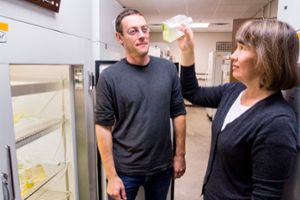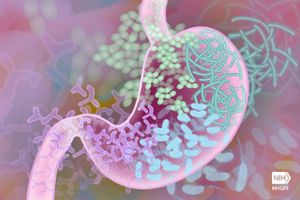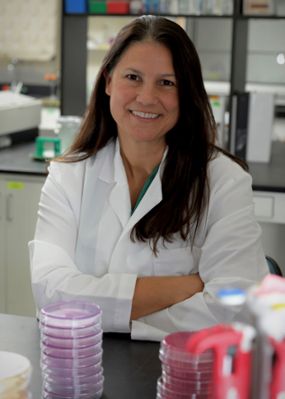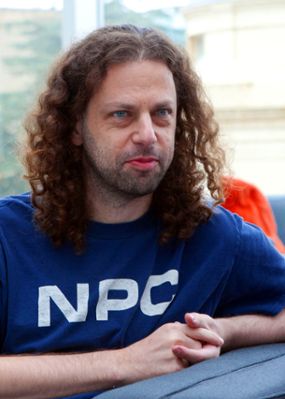Into the microbiome: Exploring the ecology of microbial communities
It takes one to know one—a community that is.
With that in mind, a community of pioneering scientists from Michigan State University’s College of Natural Science and the University of California, Los Angeles, came together to design a multifaceted approach to investigating one of the most complex and abundant communities on Earth—microbiomes.

The project, “Using multilayer interaction networks to predict microbiome assembly and function,” received a 3-year, $936,000 National Science Foundation (NSF) grant as part of the NSF’s 10 Big Ideas. Their innovative project falls under “Understanding the Rules of Life: Microbiome Interactions and Mechanisms,” a sweeping idea to elucidate sets of rules that can predict relationships between and within organisms—so called “rules” for how life functions.
MSU Foundation Professor Elena Litchman who holds joint appointments in the W.K. Kellogg Biological Station (KBS) and the Department of Integrative Biology (IBIO) is leading the grant. Shannon Manning, MSU Foundation Professor in the Department of Microbiology and Molecular Genetics (MMG), and Christopher Klausmeier, MSU Foundation Professor in the Department of Plant Biology and IBIO, and a KBS faculty member, are Co-PIs. Mason Porter, professor of mathematics at the University of California, Los Angeles, is the final collaborator.
“In any ecological community you have members interacting with each other,” said Litchman, whose research focuses on the community dynamics of microorganisms. “They can compete for resources, or they can benefit each other by providing each other with resources. These types of interactions and their effects are still not well understood in microbiomes, so we are taking principles from the community ecology of other systems and applying them to microbial communities.”

Microscopic communities are the foundation for all ecosystems on Earth and essential to plant, animal and human well-being. The scientists will focus on host-associated microbial communities, or those that flourish inside another organism, like in the human gut. While the medical field has given these organisms a lot of attention and produced an astonishing amount of datasets on their genetic make-up, investigating the relationship between microbial structure and function from an ecological perspective is still lagging—until now.
“Understanding microbial community structure is the same problem as understanding plant community structure,” said Klausmeier, whose KBS lab is a leader in theoretical understanding of the principles that organize ecological communities and ecosystems. “A forest in Michigan has maple and beech, tropical rainforests have different species and prairies a completely different set of plants. The same idea applies to the microbes in guts, we just don’t think about it that way because we are not walking through them like we walk through forests.”
The scientists will take a three-pronged approach to understanding the microbiomes. First, Litchman and Klausmeier will continue developing simplified models of microbial communities that capture the mechanistic details of microbe interactions over time. Specifically, microbes’ ability to adapt and respond to disturbances such as antibiotics or pathogens. While the number of microbes in their models may be small, the interactions between them add up exponentially.
“It was a lot of work to figure out mutualistic and competitive interactions between two species, and when we move up to three, there are even more possible combinations,” Klausmeier explained. In fact, the Human Microbiome Project estimates there could be over 2,000 species of bacteria in the human gut. “It becomes impossible to model all the possible interactions in diverse communities because the number just blows up,”

To predict how microbes in the more complex communities interact, the team will utilize rich datasets provided by Manning. Her microbiological investigations into how microbiomes react after invasions from pathogenic bacteria will ground theoretical predictions based on wild-type microbes circulating out in the world.
“We have worked with the Michigan Department of Health and Human Services to obtain stool samples from patients with diarrhea caused by 4 of the most common foodborne pathogens in the United States: Shiga toxin-producing E. coli, Shigella, Salmonella, and Campylobacter,” said Manning, whose team isolated a subset of samples from the same patients after they recovered. “Understanding which microbial populations and functions fail to rebound following an infection can aid in the identification of new therapeutics that may be used to restructure the microbiome to a healthier state.”
Like the relationship between the forest floor, the understory and the tree canopy, microbes are related to each other on different levels, the scientists explained. In the microbiome, several network layers exist at once: the species themselves, their resource use and exchange, toxin production, temporal disturbance and others. Porter will apply mathematical network theory to the microbial datasets, combining the previous stages of modeling into an analysis of the relationship between these distinct layers.

“Multilayer network analysis is an increasingly extensive area of network science,” said Porter, whose open-source software created for the project will have ripple effects in the study of other human and natural systems. “It is important to apply these ideas to new systems and to challenge and extend our tools as a result of these applications.”
The team’s grant will also support a community of undergraduate and graduate students and postdocs at MSU and UCLA who will receive technical training and participate in a cross-university seminar open to other researchers on the topic of understanding interactions in microbial communities using theory and data. The dynamic computer code and models will also be publicly available through sites such as Bitbucket and GitHub and will be adapted as hands on exploratory activities for high school students to learn about microbiomes.
“We are excited that we have this range of expertise from conceptual community ecology to mathematical ecology to applied math to microbiology and pathogenesis,” Litchman said. “Applying ecological principles and mathematical models to microbial datasets is still in its infancy, so it felt like our team could really tackle this and get results that are of fundamental ecological interest and have numerous health applications.”
Banner image: A team of renowned scientists from MSU and UCLA will begin a first-of-its-kind ecological investigation into the complex network of host-associated microbiomes like those found in the human gut. Credit: Darryl Leja, National Human Genome Research Institute, National Institutes of Health